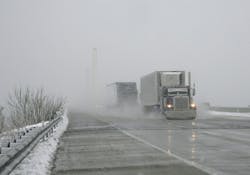Helping cargo, truck drivers weather winter's wrath
As winter weather continues to create havoc for roadway users of all stripes in the U.S. – with yet another winter storm taking aim at Georgia this week – a variety of tactics are being deployed to help trucking companies deal better with snow and ice conditions, but help better protect cargo in transit as well.
For starters, a variety of new snow and ice removal tactics and technologies are being deployed by state and local highway crews around the country. One example is a 26-foot-wide “tow plow” – the brainchild of a Missouri Department of Transportation (MoDOT) – designed to be pulled behind a conventional plow truck, allowing two interstate travel lanes to be cleared and treated in a single pass.
This device, now in use for several years, has been adopted by several state DOT agencies for highway snow and ice removal work, according to American Association of State Highway and Transportation Officials (AASHTO).
[A video shot last year demonstrating how the “two plow” operates can be viewed below.]
Daniel Brown, risk control technical manager for the Travelers insurance firm, told Fleet Owner that since commercial fleets still must continue delivering food and other necessities regardless of the weather conditions, managing operations safely during winter storms takes on greater significance.
“Because commercial drivers don’t always have the luxury of staying home if the weather is bad, they often are on the road during the worst driving conditions to deliver products and services everyone relies on,” he explained. “Some of the other drivers on the road may be less experienced or take unnecessary risks, which makes it even more important for professional drivers to be patient and drive defensively.”
Brown stressed that preparation for handling inclement weather “is vital” and recommends that transport companies take following precautions before sending drivers out on the road:
- Plan ahead. Fleet managers need to help drivers by planning for inclement weather in advance and factoring in road and weather conditions. Appointments may need to be rescheduled and customers notified. Drivers may be more likely to drive safely if they know a customer has been notified and understands the situation. When driving conditions are tough, it’s not a good time for drivers to feel pressured to keep an appointment.
- Conduct inspections and maintenance. It’s important to make sure vehicles are in good working condition to avoid a situation where a driver becomes stranded because their vehicle broke down. Breakdowns are not only costly, but can also be dangerous. A lot of serious accidents involve vehicles that are stranded on the side of the road.
- Take the driver’s judgment into account. Companies need to trust their driver’s judgment about local driving conditions and encourage them to make safe decisions about how to drive or whether to park and wait for conditions to improve.
“It’s important for commercial drivers to be especially cautious on the roads during this time because of their size and weight, commercial vehicles can be involved in more serious accidents, especially if passengers or valuable cargo are involved,” Brown said. “If a heavy truck loses control, significantly more damage can occur compared to a 2,000 pound passenger vehicle.”
Protecting cargo from the impact of low temperatures is another critical tactic as well, explained Tommy Walker, director of chemical marketing and compliance for regional carrier A. Duie Pyle, as even mundane good such as paint can be significantly affected by the bitter cold.
“For example, over the years EPA [Environmental Protection Agency] rules have removed VOCs [volatile organic compounds] and other such solvents from paint and as a consequence many paints have moved to water-based latex formulas,” he said. “When you reach 32 degrees Fahrenheit or lower, though, such protects can freeze solid and thus become worthless.”
To insure that doesn’t happen, Walker noted that A. Duie Pyle invested in fully-insulated trailers equipped with diesel-fired heaters to prevent goods from freezing during transport, as well providing insulated “blanket wraps” for cargo skids as well as heating sections of loading docks at the company’s terminals.
“We can get a shipment delay order, which often means we need to keep cargo in ‘protective custody’ for 24 hours,” he pointed out. “So we’ll store that cargo in the heated section of our terminals.”
As A. Duie Pyle primarily serves the Northeastern U.S., it’s also equipped many of its terminals with “plug in” ports to keep the diesel engines of its trucks warm overnight, Walker said.
“We also keep the equipment in our fleet as ‘young’ as possible with newer trucks as they tend to withstand the elements better than older models,” he added. “The weather really never stops and can make trucking operations difficult. But we’re used to it here in the Northeast so we’re trying to provide more and more ‘weather customized’ services to help our customer base.”
